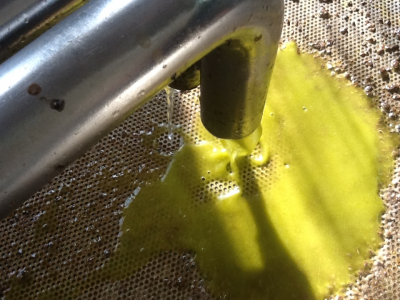The journey of the olives in the mill
Expertise. What happens when we bring our olives to the mill to extract their precious juice? Do we know what the various steps in the process are? What happens exactly throughout the stages of washing and defoliation, milling and malaxation, extraction and separation and what is the role of temperature in these processes? All we need to know.

The journey that the olives embark on to become oil consists of a number of crucial steps that deserve to be better known. These stages are mandatory, and we should analyse them in depth, so as to know how to proceed when producing olive oil.
Washing and defoliating the olives
To many, this may seem a rather pointless operation, but actually, it is very important that the olives be clean and free of debris before they are milled. The more modern machinery used to harvest them, such as shaker bars fitted at the back of a tractor, yield large amounts of olives in little time, but the drawback is that they cause more leaves and twigs to fall into the nets than the more traditional, hand-picking methods. All foreign matter must be removed before processing the olives, and specific machines are installed for this purpose, either in the washing unit or outside the mill. A defoliator, if necessary a destoner, and an adequate washing system ensure the levels of hygiene required for a product of higher-quality. The frequency with which the water in the washer is changed is also important. Although the water is decanted before being recycled through a system of communicating vessels, a procedure that ensures it remains clean for longer periods of time, every so often it must be changed. Be careful however, if you ask the miller to change the water he might react in an unpleasant manner… The general rule is to change the water every eight hours; the amount of time however can vary extensively, according to how dirty the olives are when they arrive to the mill.
Crushing
There are countless types of crushing machines on the market (hammer crushing machines, disc or blade machines, depitting machines and so forth), but in all of them there are various parameters that can be regulated, the most important of which are spinning rate of the crushing organs and the texture of the resulting olive paste. Obviously, the results differ extensively, according to the crushing machine employed, but even the same machine can yield very different types of paste, if regulated appropriately. Some crushing machines are easier to adjust than others, and this is why it is more common to see a miller regulating the distance between the discs, rather than changing its grids. This type of regulation makes it possible to increase or decrease the smoothness of the olive paste. Early in the harvesting season, a coarser paste is more common, whereas as the weeks go by, a smoother texture is usually considered preferable. Adjustments are also made depending on which of the countless cultivars present in our country is processed, and many are the results that can be obtained by fine tuning this parameter.
Also the spinning rate of the crushing organs can be modulated. although less frequent, this type of adjustment can be made, thanks to the inverter connected to the motor of the crushing machine, which controls the number of revolutions per minute, resulting in a more or less “powerful” crushing motion. This type of regulation is extremely easy to carry out, because it is done using a digital control panel, and its effects are immediate.
Malaxation
The parameters that can be adjusted during this stage are essentially two: time and temperature. Before considering making any adjustment, it is important to take into account how the malaxing machine is designed and its technological level. Theoretically speaking, varying the malaxation time is simple. However, the malaxing process line is made up of various units, and each of these machines has a given feed and discharge time. Various batches of olives can be processed contemporaneously, and indeed, a skilled miller is able to combine various lots, so as to optimize the performance of the plant and improve customer service. For this reason, do not be upset if somebody passes in front of you at the mill, for you have a fifty-fifty chance that it is to your benefit: the miller will most certainly have taken various factors into account, usually linked to the amount of olives processes, to ensure that you receive the best service possible.
Temperature
In state of the art mills, it is quite simple to programme the desired temperature of each malaxing unit, so in these cases, you can ask the miller to process your olives at whatever temperature you desire. If you want to claim that your oil is “cold-pressed”, ridiculous as this term now is, you must request a temperature below 27°C. A digital or computerised thermostat is used to regulate the temperature of the units. In certain cases however, the thermostat controls the temperature of the entire malaxing line, and in this case, you must accept the settings made by the miller, and process your olives at whatever temperature the other batches are malaxed at.
As mentioned previously, the technological level of the malaxing machines is another critical factor. They may be fairly obsolete, with units installed in line instead of in parallel, perhaps even heated by water coming directly from the boiler, instead of a heat exchanger, or on the other hand, you may be lucky enough to be able to process your olives in hermetically sealed malaxing units, which limit the contact with the oxygen present in the air and therefore reduce the risk of oxidising the olive paste. These are extreme cases. Attention to detail however makes all the difference, so these things must be taken into account, in order that the adjustments made yield the required outcome.
Extraction
This is definitively the most “mystical” stage of the process: the olive paste loses its triune nature and becomes oil, water and dry pomace (3-phase extraction) or oil and moist pomace (2-phase). Incidentally, I would like to clarify that there is no such thing as an intermediate combination, the so-called 2 and a half phase is only a marketing gimmick, a term that has become more popular than advanced dual phase, triple phase extraction or water-saving extraction. It might be best to define these systems as classic and modern 3-phase extraction systems, respectively, the latter one including all those decanters employing a limited amount of water to extract the oil from the paste (process water). There are either 2 or 3 products coming out of the machine, no intermediate number. Without dwelling on the advantages and drawbacks of either system, what is certain is that the decanter is the undisputed king of the mill, and as such, deserves the greatest respect. There are various parameters that can be regulated: paste feeding rate, amount of process water (only for 3-phase decanters), differential speed between screw conveyor and bowl, pond depth.
The feeding rate – usually expressed in m3/hour – depends on the capacity of the decanter, and every decanter has an average reference flow rate, which can however vary according to the type of olives processed and how ripe they are. It is the miller’s task and ability to set the optimal flow rate of the decanter, lowering it when necessary, as in the case of difficult olives, or raising it when possible, without however exceeding the maximum flow rate indicated by the manufacturer.
Process water is a critical component, especially in the presence of a difficult batch of olives, which can yield large amounts of sludge: in these cases it is necessary to increase the flow of water employed, whereas when simpler olives are processed in advanced 3-phase decanters, one can even operate in the absence of water.
Oil extraction can be optimised by adjusting the differential speed between screw conveyor and bowl, because this parameter controls the length of time that the olive paste spends in the decanter centrifuge and therefore the use efficiency of the machine. Some types of decanter are endowed with an electronic control panel through which one can adjust this parameter directly, without having to stop the machine. In general, a skilled miller is able to modify the processing parameters of the centrifuge at every new batch, adapting the machine to the type of olives processed.
As regards the pond depth, modifying this parameter (by acting on the overflow weir) usually requires stopping the machine: these are interventions that are carried out only under exceptional or very specific circumstances, such as in the presence of major problems.
Clarification
If the decanter centrifuge is the king of the mill, then the separator is its prince. It is important that the centrifuge yields an oil free of water particles and olive residues in order for it to have an adequate shelf life, even when filtration systems are present downstream the centrifuge, because these alone may not be sufficient.
The main thing is to use the appropriate regulation ring, so that the oil coming out of the system is as clear as possible and that there are no risks of contamination (presence of oil in the water or vice versa). Great attention is always paid to this critical step, and rarely something goes wrong during this stage.
It is very important to keep the separator perfectly efficient, by servicing it regularly, cleaning it – the so-called blasting, which removes all solid particles – as well as washing it every time difficulties arise when clarifying the oil. The latter operation may be performed either manually or with automatic devices.
Unless we is lucky enough to own an olive mill, and can therefore adjust any parameter as desired, we must always be willing to accept some degree of compromise when we bring our olives to be processed. When we entrust our olives to the miller, we are also handing over a great responsibility, and this is true for every customer contemporaneously present in the mill. We must know what we want, but also try to be understanding.
Photo by Luigi Caricato
To comment you have to register
If you're already registered you can click here to access your account
or click here to create a new account


Comment this news